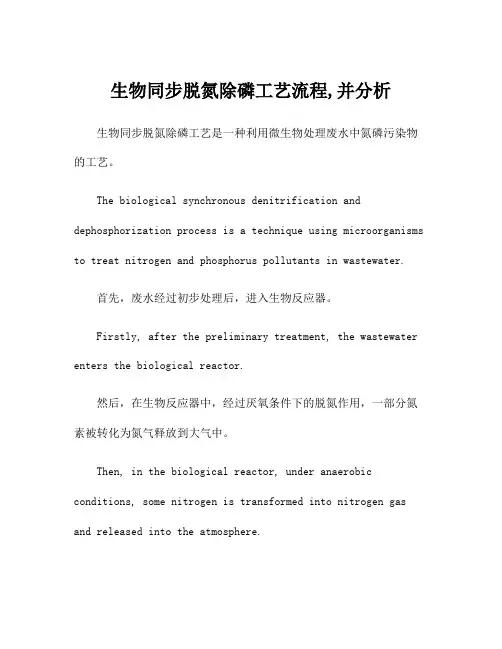第4章 生物脱氮除磷工艺
- 格式:ppt
- 大小:801.00 KB
- 文档页数:40


生物脱氮除磷工艺生物脱氮除磷工艺是一种通过微生物代谢作用来减少废水中氮和磷的浓度的工艺。
该工艺逐渐被广泛应用于城市污水处理、农业生产、工业废水处理等领域。
生物脱氮除磷工艺涉及多个过程,包括生物脱氮池、一/二级沉淀池、生物滤池、化学除磷装置等。
其中生物脱氮池和生物滤池是主要的过程单元。
生物脱氮池是一个特殊的好氧反应器,主要是使用异养菌为营养基础,利用硝化反应将氨氮和有机氮转化为硝态氮,然后通过反硝化反应将硝态氮还原为氮气排出。
为了使池内的好氧环境被保持,池内需要提供足够的氧气。
生物滤池是一个非常重要的污水处理单位,它是通过微生物群落代谢作用,利用吸附作用来吸附废水中的氮和磷元素。
微生物生长在滤料表面,铺设在水平或者竖直的格栅上,滤料可以是沙砾、玄武岩等物质。
滤料的特殊结构、表面特性和自备的微生物群落成为生物滤池内的去除污染物的主要手段。
废水在流经滤料层时,氮和磷元素在滤料表面被吸附,吸附到细胞表面的氮被异养菌氧化为氮气,磷元素则随着污泥浓度增加,在池内逐步沉积。
生物脱氮除磷工艺的优点在于原理简单,适用范围广泛,处理效率高,成本较低,不需要大量的化学物质,并且不会产生二次污染。
然而,这种工艺也存在一些缺陷。
例如,处理后的产物含有大量的氮和磷,商业利用它们困难,造成浪费;污水中如果有过多的脂肪和油脂,可能会对生物脱氮除磷工艺产生影响,导致工艺失效。
总之,生物脱氮除磷工艺是一种受到广泛关注的废水处理方案。
未来,随着社会对环境保护意识的不断提高,生物脱氮除磷工艺势必会在更多的领域得到应用,成为减少污染物排放的重要手段。

工艺方法——生物脱氮除磷技术工艺简介一、传统生物脱氮除磷技术1、传统生物脱氮原理污水经二级生化处理,在好氧条件下去除以BOD5为主的碳源污染物的同时,在氨化细菌的参与下完成脱氨基作用,并在硝化和亚硝化细菌的参与下完成硝化作用;在厌氧或缺氧条件下经反硝化细菌的参与完成反硝化作用。
2、传统生物除磷原理在厌氧条件下,聚磷菌体内的ATP进行水解,放出H3PO4和能量形成ADP;在好氧条件下,聚磷菌有氧呼吸,不断地放出能量,聚磷菌在透膜酶的催化作用下利用能量、通过主动运输从外部摄取H3PO4,其中一部分与ADP结合形成ATP,另一部分合成聚磷酸盐(PHB)储存在细胞内,实现过量吸磷。
通过排除剩余污泥或侧流富集厌氧上清液将磷从系统内排除,在生物除磷过程中,碳源微生物也得到分解。
3、常用工艺及升级改造具有代表性的常用工艺有A/O工艺、A2/O工艺、UCT工艺、SBR 工艺、Bardenpho工艺、生物转盘工艺等,这些工艺都是通过调节工况,利用各阶段的优势菌群,尽可能的消除各影响因素间的干扰,以达到适应各阶段菌群生长条件,实现水处理效果。
近年来随着研究的深入,对常用工艺有了一些改进,目前应用最广泛、水厂升级改造难度较低的是分段进水工艺。
与传统A/O工艺、A2/O工艺、UCT工艺等相比,分段进水工艺可以充分利用碳源并能较好的维持好氧、厌氧(或缺氧)环境,具有脱氮除磷效率高、无需内循环、污泥浓度高、污泥龄长等优点。
分段进水工艺适用于对A/O工艺、A2/O工艺、UCT工艺等的升级改造,通过将生化反应池分隔并使进水按一定比例分段进入各段反应池,以充分利用碳源,解决目前污水处理厂普遍存在的碳源不足和剩余污泥量过大的问题。
分段进水工艺虽然对提高出水水质有较好的效果,但该工艺并不能提高处理能力,当水厂处于超负荷运行时,分段进水改造也不能达到良好的处理效果。
二、新型生物脱氮除磷技术近年来,科学研究发现,生物脱氮除磷过程中出现了超出传统生物脱氮除磷理论的现象,据此提出了一些新的脱氮除磷工艺,如:短程硝化反硝化工艺、同步硝化反硝化工艺、厌氧氨氧化工艺、反硝化除磷工艺。


生物同步脱氮除磷工艺流程,并分析生物同步脱氮除磷工艺是一种利用微生物处理废水中氮磷污染物的工艺。
The biological synchronous denitrification and dephosphorization process is a technique using microorganisms to treat nitrogen and phosphorus pollutants in wastewater.首先,废水经过初步处理后,进入生物反应器。
Firstly, after the preliminary treatment, the wastewater enters the biological reactor.然后,在生物反应器中,经过厌氧条件下的脱氮作用,一部分氮素被转化为氮气释放到大气中。
Then, in the biological reactor, under anaerobic conditions, some nitrogen is transformed into nitrogen gas and released into the atmosphere.在同一时间,另一部分废水中的氮素被转化为氮氧化物,并在需要氧气的氧化条件下被进一步处理。
At the same time, another portion of nitrogen in the wastewater is converted to nitrogen oxides and further treated under aerobic conditions requiring oxygen.除氮后,废水进一步进入磷的处理阶段。
After denitrification, the wastewater further enters the phosphorus treatment stage.在此阶段,废水中的磷会被吸附到生物污泥上,从而将磷从废水中去除。


2.除磷系统的效率影响因素。
①PH 7-8之间;②好氧区中溶解氧2mg/L以上;/P大于10,出水P浓度可降至1mg/L左右;③进水中易降解COD浓度,当BOD5④低污泥负荷和高SRT对除磷过程不利。
当SRT较长时,聚磷菌处于较长的内源呼吸期,会消耗细胞内较多的贮存物质,影响厌氧区对VAF的吸收和PHB的转化,使整个系统的除磷效率降低。
3.A2/O过程中P去除效果变差的原因。
(2012)①进入沉淀池的混合液通常需要保持一定的溶解氧浓度,以防止沉淀池中反硝化和污泥厌氧释磷,但这同时导致回流污泥和回流混合液中存在一定的溶解氧,影响厌氧释磷过程;②回流污泥中存在的硝酸盐进行反硝化作用,消耗系统中的易降解COD造成碳源不足的问题;③系统所排放的污泥中仅有一部分是经历了完整的厌氧和好氧过程,影响了污泥的充分吸磷;④系统污泥泥龄因为兼顾硝化菌的生长而不可能太短,导致除磷效果难以进一步提高。
4.氨氮的氨氧化原理。
(2013)5.结合N去除的工艺流程,浅述氨氮和总氮的去除途径。
(2012)6.论述生物脱氮除磷中,碳源的重要性以及碳源不足时应采取什么措施(2011)(2009)碳,是微生物生长需要量最大的元素。
在脱氮除磷系统中,碳源大致上消耗于释磷,反硝化和异养菌正常代谢等其他方面,其中释磷与反硝化过程的反应速率与进水碳源中易降解部分,尤其是挥发性有机脂肪酸(VFA)的数量关系很大。
在生物脱氮的缺氧区,易降解COD浓度越高,则硝酸盐反硝化速率越快,缺氧池容积可以减少,反硝化效率高;在生物除磷的厌氧区,易降解COD浓度越高,释磷越充分,除磷效果越好。
解决方法:一从工艺外部采取措施。
增加进水中易降解COD的数量,例如取消初沉池,或设置短时初沉池、污泥消化液回流或将初沉池改为酸化池等;二从工艺内部考虑。
合理为反硝化和释磷分配碳源,将厌氧区前置,缺氧区后置;预处理单元不能过度曝气,同时曝气池为不减少曝气量以降低回流混合液中的DO浓度;降低回流污泥中的硝酸盐含量等。

描写蝴蝶的种类可真多总分结构的英语作文全文共3篇示例,供读者参考篇1The Wondrous World of ButterfliesButterflies are one of the most fascinating creatures on our planet. As a student of nature, I've always been captivated by their delicate beauty and the incredible diversity within their species. From the vibrant colors that adorn their wings to the intricate patterns that seem to tell a story, each butterfly is a living work of art. In this essay, I'll take you on a journey through the wondrous world of butterflies, exploring their vast array of species and the remarkable structures that enable their enchanting existence.The Kaleidoscope of SpeciesWhen one thinks of butterflies, the first image that often comes to mind is the iconic Monarch butterfly, with its striking orange and black wings. However, this is merely a glimpse into the incredible spectrum of species that grace our world. Butterflies come in a dazzling array of colors, shapes, and sizes, each one a unique masterpiece crafted by nature.One of the most eye-catching varieties is the Swallowtail butterfly, characterized by its elongated hindwings that resemble tails. These graceful creatures can be found in a multitude of hues, from the vibrant yellow of the Eastern Tiger Swallowtail to the deep blue of the Pipevine Swallowtail. Their intricate patterns and intricate markings are a true feast for the eyes.Another captivating group is the Brush-footed butterflies, which include the well-known Painted Lady and Red Admiral. These butterflies are known for their bold, contrasting colors and the distinctive eye-spots on their wings, which serve as a defense mechanism against predators.The world of butterflies is not limited to the temperate regions, as there are countless species that thrive in the tropics. The Morpho butterflies, native to Central and South America, are a prime example of this tropical splendor. Their wings possess an iridescent blue hue that seems to shimmer and shift as they flutter by, a mesmerizing display of nature's artistry.Structural MarvelsWhile the beauty of butterflies is undeniable, their true wonder lies in the intricate structures that enable their extraordinary abilities. From their delicate wings to their intricatemouthparts, each component is a testament to the ingenuity of evolution.The wings of a butterfly are perhaps their most iconic feature, and their structure is nothing short of remarkable. Composed of a thin membrane reinforced by a network of veins, these wings are both lightweight and incredibly strong. The patterns and colors we admire are created by tiny scales that overlap like shingles on a roof, each one reflecting and refracting light to produce a dazzling array of hues.Equally fascinating are the mouthparts of a butterfly, which are designed for sipping nectar from flowers. Their long, coiled proboscis unfurls like a tiny straw, allowing them to access the sweet nectar deep within the blossoms. This incredible adaptation not only sustains the butterflies but also plays a crucial role in pollination, ensuring the continuation of countless plant species.The legs of a butterfly are another marvel of engineering. While they may appear delicate, these appendages are strong enough to support the butterfly's weight and provide a secure grip on various surfaces. Additionally, many species possess specialized structures on their legs that aid in the collection of pollen or the detection of potential mates.Life Cycle and MetamorphosisThe journey of a butterfly is perhaps one of the most remarkable transformations in the natural world. Beginning as a tiny egg, the butterfly undergoes a series of metamorphic stages that are nothing short of awe-inspiring.The first stage, the larva or caterpillar, is a voracious eater, consuming vast amounts of plant matter to fuel its growth. During this phase, the caterpillar sheds its skin multiple times, a process known as molting, to accommodate its rapidly expanding body.When the time is right, the caterpillar enters the pupal stage, forming a protective casing around itself known as a chrysalis. Within this seemingly lifeless shell, an extraordinary transformation takes place. The caterpillar's body breaks down, and its cells reorganize into the intricate structures of a butterfly, including wings, legs, and mouthparts.Finally, after weeks or months of metamorphosis, the adult butterfly emerges from the chrysalis, unfurling its wings and taking its first flight. This incredible journey serves as a powerful metaphor for growth, change, and the resilience of life.Ecological ImportanceButterflies are not only beautiful to behold but also play a vital role in the delicate balance of our ecosystems. As pollinators, they facilitate the reproduction of countless plant species, ensuring the continuation of diverse and thriving plant communities.Furthermore, butterflies serve as important indicators of environmental health. Their sensitivity to changes in their habitat makes them excellent barometers for detecting shifts in climate, pollution levels, and habitat degradation. By monitoring butterfly populations, scientists can gain valuable insights into the overall well-being of an ecosystem and take necessary steps to preserve and protect these fragile environments.ConclusionThe world of butterflies is a tapestry of beauty, diversity, and wonder. From the kaleidoscope of species that grace our planet to the intricate structures that enable their extraordinary abilities, these delicate creatures never cease to inspire awe and appreciation.As a student of nature, studying butterflies has taught me valuable lessons about the resilience of life, the intricate balance of ecosystems, and the importance of preserving the natural world. Each flutter of their wings reminds us of the beauty thatsurrounds us and the responsibility we hold as stewards of this incredible planet.So, the next time you encounter a butterfly, take a moment to truly appreciate its magnificence. Marvel at the vibrant colors, the delicate patterns, and the incredible journey it has undertaken to reach this fleeting moment of grace. For in that brief encounter, you will have witnessed a living masterpiece, a testament to the wonders of nature that continue to inspire and captivate us all.篇2The Wondrous World of ButterfliesAs I gaze out the window on this warm spring day, my eyes are instantly drawn to the fluttering of delicate wings in the garden. A kaleidoscope of colors dances before me - rich oranges, vivid blues, and dazzling blacks adorned with iridescent spots. The butterflies have emerged from their chrysalises, and their arrival marks the beginning of a new season of beauty and transformation in nature.Having always been fascinated by these ethereal creatures, I decided to delve deeper into the world of butterflies. Little did I know that this journey would unveil an astounding diversity ofspecies, each with its own unique characteristics and behaviors. It is a world that has captured the imagination of scientists, artists, and nature enthusiasts alike for centuries.One of the first revelations that struck me was the sheer number of butterfly species that exist on our planet. From the vast rainforests of the Amazon to the arid deserts of Africa, these winged wonders can be found in nearly every corner of the globe. According to estimates, there are approximately 20,000 different species of butterflies, with new ones still being discovered every year.Each species is a masterpiece of evolution, adapted to thrive in its specific habitat and environment. Take, for instance, the stunning Morpho butterflies of Central and South America. Their iridescent blue wings are not a result of pigmentation but rather a structural phenomenon called "photonic crystals." These microscopic structures on their wing scales reflect specific wavelengths of light, creating a mesmerizing display of color that shifts and shimmers as the butterfly moves.In contrast, the Monarch butterfly, perhaps one of the most well-known and recognizable species, is famous for its remarkable migration patterns. Every year, millions of these orange and black beauties embark on a perilous journey fromthe United States and Canada to their overwintering grounds in Mexico and California. This incredible feat, spanning thousands of miles, is a testament to the resilience and navigational prowess of these delicate creatures.As I continued my research, I couldn't help but marvel at the intricate life cycle of butterflies. From the humble beginnings as a tiny egg, they undergo a complete metamorphosis, transitioning from a voracious caterpillar to a remarkable winged adult. The process of metamorphosis itself is nothing short of miraculous, as the caterpillar essentially digests itself from the inside out, reorganizing its cells and tissues to form the butterfly we admire.One aspect that particularly fascinated me was the diversity of strategies employed by different butterfly species to ensure their survival. Some, like the Viceroy, have evolved to mimic the appearance of less palatable species, such as the Monarch, to deter predators. Others, like the Swallowtails, rely on their incredible speed and agility to evade potential threats.As I delved deeper into the world of butterflies, I couldn't help but notice the common structural elements that unite these diverse species. Despite their differences in color, size, andhabitat, all butterflies share a basic body plan that has evolved over millions of years.At the core of a butterfly's anatomy is the exoskeleton, a lightweight yet sturdy external covering that protects its internal organs and provides support for its delicate wings. This exoskeleton is composed of a series of plates, or sclerites, interconnected by flexible membranes, allowing for movement and flexibility.The wings, perhaps the most striking feature of a butterfly, are composed of two pairs – the forewings and the hindwings. Each wing is formed by a double layer of chitin, a tough, flexible material that is both lightweight and durable. Within this layer are intricate patterns of veins that provide structural support and act as channels for the hemolymph, the butterfly's circulatory fluid.Adorning the wings are the scales, tiny, overlapping structures that are responsible for the vibrant colors and patterns we associate with butterflies. These scales are essentially flattened, modified hair-like structures composed of chitin and pigments. The arrangement and composition of these scales create the mesmerizing hues and patterns that captivate our eyes.At the heart of a butterfly's anatomy lies the thorax, a robust and muscular segment that houses the powerful flight muscles. These muscles, attached to the wings via a complex system of tendons, allow the butterfly to achieve its graceful and agile flight. The abdomen, located posterior to the thorax, houses the digestive and reproductive systems, ensuring the continuation of the species.As I concluded my research, I couldn't help but feel a profound sense of awe and appreciation for these delicate creatures. Butterflies serve as a reminder of the incredible diversity and complexity of life on our planet. From their intricate life cycles to their remarkable adaptations, they are living works of art, adorning our gardens and landscapes with their beauty.In many ways, the world of butterflies reflects the intricate tapestry of nature itself – a tapestry woven with threads of adaptation, resilience, and breathtaking beauty. As I continue to observe and appreciate these winged wonders, I am reminded of the importance of preserving and protecting their habitats, ensuring that future generations can experience the magic and wonder of these captivating creatures.篇3The Wondrous World of ButterfliesButterflies are one of the most fascinating creatures on our planet. As a student of nature, I've spent countless hours observing these delicate, winged beauties and marveling at the incredible diversity found within their ranks. From the vibrant colors that adorn their wings to the intricate patterns and shapes that seem to defy imagination, each butterfly species is a masterpiece in its own right.One of the most striking aspects of butterflies is the sheer number of species that exist. According to estimates, there are over 20,000 different kinds of butterflies worldwide, each with its own unique characteristics and adaptations. This staggering variety is a testament to the incredible evolutionary journey these insects have undergone, adapting to different environments and ecological niches across the globe.As I delve deeper into the study of butterflies, I've come to appreciate the remarkable structural features that enable their existence. At the heart of a butterfly's anatomy lies a comprehensive yet delicate body plan that has been fine-tuned over millions of years of evolution.Let's start with the wings – the most visually captivating aspect of these creatures. Butterfly wings are composed of a thin,membranous material called chitin, overlaid with thousands of tiny scales. These scales, arranged in intricate patterns, are responsible for the stunning array of colors and designs that adorn a butterfly's wings. The scales act as microscopic prisms, reflecting and refracting light in ways that produce the vibrant hues we see.But the wings serve a far more vital purpose than mere aesthetics. They are the key to a butterfly's ability to take flight, with each pair of wings working in synchrony to generate lift and propel the insect through the air. The structure of the wings is a marvel of engineering, with a network of veins and ridges providing both strength and flexibility.Moving beyond the wings, we encounter the butterfly's thorax – the middle section of its body. This is where the powerful flight muscles are housed, enabling the rapid beating of the wings that keeps these creatures aloft. The thorax also serves as an attachment point for the legs, which play a crucial role in perching, feeding, and other vital activities.The butterfly's abdomen, located at the rear of its body, is a hub of essential functions. It houses the digestive system, which breaks down the nectar and other plant juices that sustain these insects. The abdomen also contains the reproductive organs,ensuring the continuation of each species through the production of eggs.One of the most fascinating aspects of butterfly anatomy is the proboscis – a long, coiled tube that extends from the head. This remarkable structure allows butterflies to feed by unfurling and inserting it into flowers, sipping nectar like a straw. The proboscis is a true evolutionary marvel, perfectly adapted for extracting precious nutrients from the depths of a blossom.As I continue to study these incredible creatures, I'm constantly amazed by the sheer diversity of adaptations and specialized features found among the various butterfly species. Some, like the Monarch, undertake extraordinary migrations spanning thousands of miles, navigating using celestial cues and an innate sense of direction. Others, like the Glasswing, have evolved transparent wings that render them nearly invisible to predators.The more I learn about butterflies, the more I realize how much there is still to discover. Each species is a unique tapestry of form and function, woven together by the intricate threads of evolution. From the delicate brushfoot butterflies that grace our gardens to the massive and imposing swallowtails of the tropics,the world of these winged wonders is a kaleidoscope of beauty and biological ingenuity.As a student of nature, I feel incredibly fortunate to have the opportunity to study these remarkable creatures. With every observation and every new piece of knowledge gained, my appreciation for the wondrous world of butterflies deepens. Their diversity, their structural marvels, and their vital roles within ecosystems serve as a constant reminder of the incredible richness and complexity of life on our planet.So, the next time you see a butterfly fluttering by, take a moment to truly appreciate the intricate design and evolutionary journey that has shaped this delicate creature. Marvel at the colors, patterns, and graceful movements that seem to defy the laws of physics. And remember, beneath that ephemeral beauty lies a masterpiece of nature's engineering – a testament to the incredible diversity and adaptation that exists in the world around us.。

生物脱氮除磷工艺简介1、生物脱氮除磷工艺的进展从20世纪60年代开始,美国曾系统地进行了脱氮除磷物化方法研究,结果认为该法的主要缺点是药耗量大,产生的污泥多,特别对处理大量城市污水时,处理成本高。
因此,转入研究生物脱氮除磷工艺。
从20世纪70年代开始,在活性污泥法脱氮工艺(A/0工艺)逐步实现工业化,并在此基础上研究开发出了生物脱氮除磷工艺(如A2/0工艺等)。
以后,随着微生物学和细胞学在污水生化处理上的新应用,又不断出现了多种变形的生物脱氮除磷工艺,如MSBR等。
我国从20世纪80年代初开始生物脱氮除磷研究,80年代后期实现了工业化流程。
污水脱氮除磷可供选择的工艺通常有生物处理和物理化学处理两大类。
后者由于需要投加相当数量的化学药剂,存在运行费用高,残渣量大和运行管理难度大等缺陷,因此,城市污水处理中一般不推荐采用。
而一般生物处理又分为活性污泥和生物膜法两种。
目前对城市污水的生物脱氮除磷工艺,指的是活性污泥生物脱氮除磷工艺。
目前已实用的几种生物脱氮除磷工艺有:A2/O、氧化沟、SBR工艺以及以上三种工艺的系列改良工艺。
2、生物脱氮除磷的工艺原理简述(1)生物脱氮首先,污水中的蛋白质和尿素等在水解酶和尿素酶的作用下转化为氨氮,而后在有氧条件下和在硝化菌的作用下,氨氮被氧化为硝酸盐,这阶段称为硝化(即氨氮转化为硝酸盐)。
再以后,在缺氮条件和反硝化菌的参与作用,并有外加碳源提供能量,硝酸盐还原成气态氮(N2)逸出,这阶段称为反硝化(即硝酸盐的氮转化为氮气)。
整个脱氮过程就是氮的分解还原反应,反应能量从有机物中获取。
在脱氮过程中,硝化菌增长速度较缓慢,所以要有足够的污泥泥龄。
反硝化菌的生长主要在缺氧条件下进行,还要有充裕的碳源提供能量,才可能使反硝化作用顺利进行。
除上述条件以外,影响脱氮效率的因素还有溶解氧,温度和PH 值等。
硝化阶段,应有足够的溶解氧,其值一般应大于2g/L。
反硝化阶段为缺氧条件,溶解氧值宜为0.4mg/L左右。

生物脱氮除磷原理及工艺生物脱氮的原理主要是利用微生物中的硝化和反硝化过程。
首先,硝化细菌通过氧化氨将氨氮转化为亚硝酸盐,然后亚硝酸盐进一步被亚硝酸盐脱氢酶转化为硝酸盐。
这个过程被称为硝化作用。
反硝化过程是指在缺氧或低氧条件下,反硝化细菌通过还原硝酸盐来释放出氮气。
生物脱磷的原理主要是利用微生物中的磷酸盐积累和释放过程。
一些细菌和藻类能够以有机物的形式从水中吸收和积累磷酸盐,并在一定条件下释放出来。
这个过程被称为磷酸盐吸收和释放作用。
通过调节水体中的氧气、有机负荷和pH值等条件,可以促进微生物的磷酸盐吸收和释放过程,从而实现生物脱磷。
非曝气法主要是在低氧或缺氧条件下进行处理。
这种方法的优点是能够节省能源和减少氧气需求,适用于中小型处理单位。
常见的非曝气法包括:厌氧氨氧化-硝化还原法(Anammox-Detritus-Anoxia法)、系统内侧流间歇式处理法(SCT法)和单球状厌氧硝化反硝化法等。
曝气法主要是通过加氧来提供充足的氧气供给,促进硝化和反硝化过程。
这种方法的优点是处理效果稳定可靠,适用于大型处理装置。
常见的曝气法包括:AO法(活性污泥法)、A2/O法(改良后的活性污泥法)和SBR法(顺序批处理法)等。
在实际的生物脱氮除磷工程中,通常会采用多级处理工艺。
例如,可以将生物脱氮和生物除磷结合起来,构建生物反硝化除磷工艺(SND)。
这种工艺可以同时去除水体中的氮和磷,效果较好。
总的来说,生物脱氮除磷通过利用微生物的生长和代谢活动,可以有效地降低水体中的氮和磷浓度,改善水质,保护生态系统。
不同的工艺可以根据具体情况选择和组合,以达到最佳的去除效果。

生物脱氮除磷工艺及研究随着水体富营养化问题的日渐突出,污水综合排放标准日趋严格,污水处理技术逐渐从以单一去除有机物为目的的阶段进入既要去除有机物又要脱氮除磷的深度处理阶段。
生物脱氮除磷技术是经济' 高效的脱氮除磷技术,在污水处理领域已得到广泛的应用。
1反硝化除磷机理生物脱氮除磷主要是利用反硝化达到除磷的目的。
生物脱氮除磷是在厌氧/缺氧环境的交替运行的条件下,易富集一类兼有反硝化作用和除磷作用的兼性厌氧微生物,该微生物能利用氧气或硝酸根作为电子受体,通过他们的代谢作用同时完成过量吸磷和反硝化过程而达到除磷脱氮的目的。
对于反硝化除磷现象研究者们提出了两种假说来进行解释:(1) 两类菌属学说,即生物除磷系统中的聚磷菌(PAO)可分为两类菌属,其中一类PAO只能一氧气作为电子受体,而另一类则既能以氧气又能以硝酸盐作为电子受体,因此他们在吸磷的同时能进行反硝化;(2) 一类菌属学说,即在生物除磷系统中只存在一类PAQ他们在一定的程度上都具有反硝化能力,该能力能否表现出来关键在于厌氧/缺氧这种交替运行的环境条件是否得到了强化。
而J.Y.Hu等通过试验发现厌氧/缺氧SBR系统中存在一类能以氧气'硝态氮' 和亚硝态氮作为电子受体的聚磷微生物,因此他将厌氧/缺氧型反硝化聚磷污泥系统的两类微生物的两类微生物菌属假说扩增到三类微生物菌属;第三类就是既能够以氧气和硝酸盐氮,也能以亚硝酸盐氮作为电子受体的类聚磷微生物。
通过总结可以确立的反硝化除磷机理: 反硝化除磷菌作为兼性厌氧细菌可以通过厌氧/缺氧条件的驯化培养大量富集;在缺氧条件下能产生分别或同时利用氧气,亚硝酸盐、硝酸盐作为电子受体的DPBo并且通过胞内PHB和糖原质的生物代谢作用来过量吸收磷,其代谢作用与传统PAO相似。
DPB体内包含3类内聚物:PHB糖原和聚磷颗粒。
首先在厌氧条件下,DPBS过厌氧释放磷获取能量体内合成PHB在缺氧条件下DPB可利用3种物质作为电子受体完成磷的摄取,同时完成反硝化过程,PHB 消耗和聚磷颗粒的生长同时进行。
生物脱氮除磷工艺演示过程氮和磷是用于废水处理的重要的微生物增长要素。
因此,在所有的生物处理过程中在一定程度上都会出现脱氮除磷。
细胞中含有约百分之十二的氮和百分之二的磷。
处理系统以营养代谢为目的,所谓的生物脱氮除磷,从本质上说组成的两个进程为:生物脱氮和强化生物除磷(EBPR )。
生物脱氮生物脱氮反应的关键过程是硝化和反硝化作用,如(图1 )。
其他相关的反应,包括氨化(有机转换氮氨)和氮素吸收的细胞生长。
硝化硝化是氨氧化成硝酸盐和亚硝酸盐。
参与反应的关键生物体是硝化和亚硝化细菌。
自养微生物通过氧化无机氮化合物获得能源:细胞生长的主要碳源是二氧化碳。
因此,有机质(BOD)是硝化反应的一个先决条件。
亚硝酸盐的积累通常不会在一个完全硝化系统中遇到,因为硝化是越来越慢,但有一些迹象表明,操作无法进行,亚硝酸盐对硝酸的转换可能成为限制因在废水的温度超过25温度到30C素,导致需要增加氯气进行消毒。
据了解,生物体可以通过硝化和反硝化调解硝化过程,因此,氨氧化细菌长期提供基板在BNR系统,硝化过程的控制因素有两个:(1 )AOBs缺乏功能多样性。
他们约占2%的微生物质量。
(2 )AOBs的敏感性要求严格的环境条件。
硝化的影响因素如下:与异养微生物相比,硝化细菌增长速度缓慢(BOD—异养微生物),可靠的硝化作用需要更长的固体停留时间。
硝化与废水温度直接相关。
•温度:硝化反应的速率随温度上升到一定点(30℃至35℃),然后下降。
具体地说,温度由20℃降至10℃,硝化反应将减少约百分之三十,只有提供三倍的MLSS,才能达到正常的出水氨氮浓度,设计系统的硝化作用通常可以应付对氨氮限制。
•溶解氧(DO ):硝化需氧量约4.6mgO2\mg NH4-N。
当溶解氧下降到远低于2 mg / L的延长时间,硝化作用将受到抑制。
•碱度和pH值:硝化作用每氧化1毫克的NH4 – N需要7.1毫克的碱(碳酸钙)。
如果进水碱度不足,硝化作用将受到抑制。